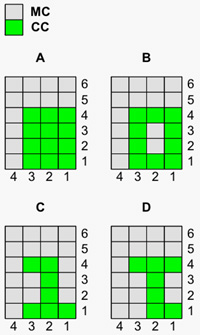
 Using
MC, CO 66 sts. Divide sts between needles
and join to begin working in the round, being
careful not to twist.
Using
MC, CO 66 sts. Divide sts between needles
and join to begin working in the round, being
careful not to twist.
K 2 rounds.
Note: For the first row of characters,
CC is joined at beginning of cursor, and broken
at end of second digit. This prevents long
yarn floats from pulling across the WS of
the work, which would distort the fabric.
First Row of Characters:
Rounds 1-3: K21 using MC, join
CC, work Chart A (cursor), work two characters
of your choice from Charts B and C, break
CC; k9 using MC, join CC, work Chart A (cursor),
work five characters of your choice from Charts
B and C, break CC.
Round 4: K21 using MC, join CC,
work Row 4 of charts as set, break CC; k9
using MC, work Row 4 of charts as set, but
do not break CC. Carry CC loosely along WS
of work while working Rounds 5 and 6.
Rounds 5-6: K all sts using MC
(rounds 5 and 6 of Charts).

 Next
Row of Characters (First Half):
Next
Row of Characters (First Half):
Rounds 1-4: [K1 using MC, work
eight characters of your choice from Charts
B and C] twice.
Rounds 5-6: K all
sts using MC (rounds 5 and 6 of Charts).
Work subsequent rows of characters in this
way until you have worked 30 rows of characters,
including first row. This point is the middle
of the scarf; if you want the finished scarf
to be longer than double its current length,
work more rows of characters.
Second Half:
Work rows of characters as for First Half,
EXCEPT choose characters from Charts B and
D. This will ensure that all the Ones are
right side up when the scarf is worn.
Continue working rows of characters until
60 rows of characters have been worked (30
rows in each half).
BO all sts.

